
Activity Reports
Snow Shoveling Volunteer Report (Ojiya City, Niigata)
March 7, 2012
The snow shoveling volunteer programme in Ojiya City, Niigata prefecture started on February 9, 2012.
A total of 150 people each day in more than 30 places participated in the activity until February 29.
This article reports about those activities. Thank you once again to all those who took part and supported this project.
According to the Ojiya City Council announcement, this year’s total amount of snowfall was as much as those of the heavy snowfall years of 1963 and 2006, 1,153 cm (as on the Ojiya City homepage, March 5 2012). Even for this area designated officially as an “extraordinary heavy snow district,” this was a remarkably heavy snowfall.
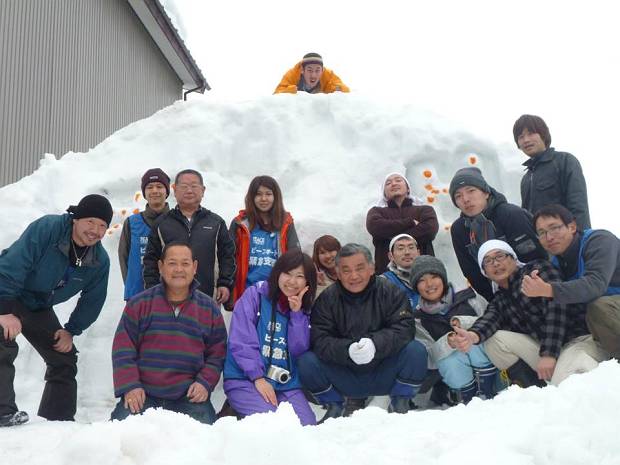
On February 9, when the four members of the advance team arrived in Ojiya City.
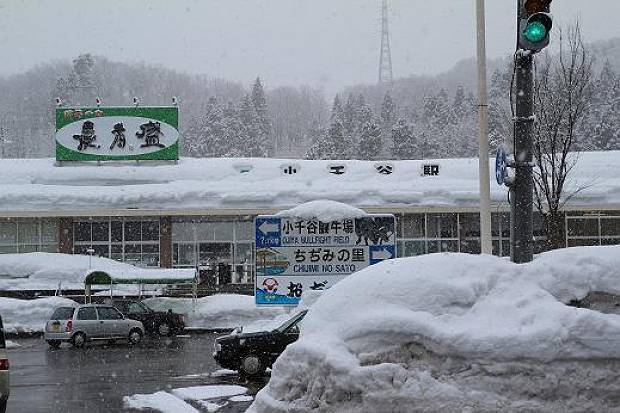
An arcade in front of Ojiya station. It was in the area surrounding the station that most activities were conducted.
If the accumulated snow on roofs was neglected, it could cause the roof to fall in. Thus, the residents clear the snow from roofs by themselves. Elderly residents who are not able to do this themselves usually employ contractors introduced by the local council to do the work for them.
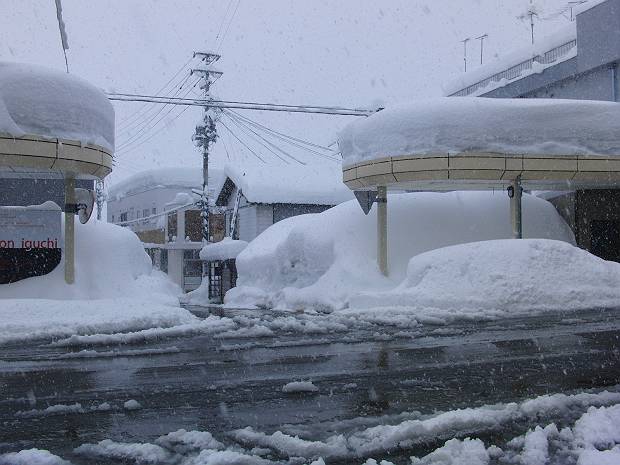
In order to prioritise safety, volunteers who were not experienced in shovelling snow primarily helped with activities on the ground level, rather than climbing on roofs.
Clearing snow is certainly hard work, and is a heavy burden on top of existing daily work and domestic commitments. In many areas snow is left to accumulate for a long time, especially in front of the houses of elderly or female only residents.
Thus, Peace Boat decided to coordinate and send volunteers to assist with snow clearance. This report outlines some of the achievements of the volunteers’ daily work.
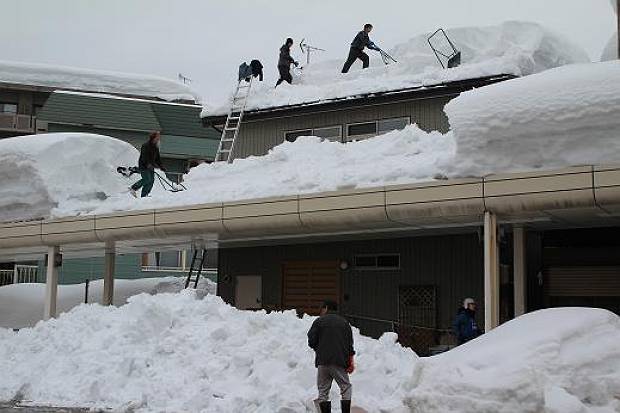
Volunteers scraping the compacted snow on top of the arcade and disposing of the snow which was blocking the road. As it was frozen it was hard to scrape off, however this clearance is vital for preventing injuries.
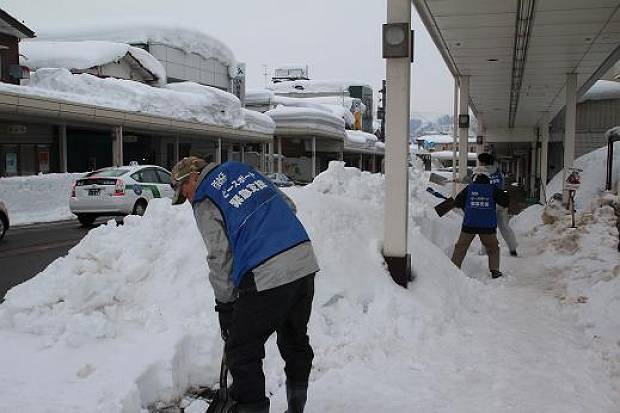
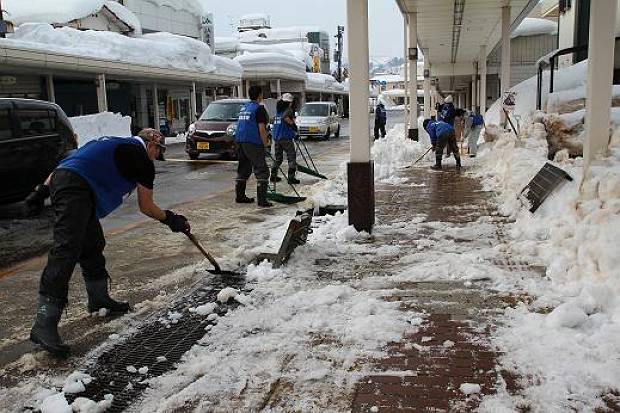
The city’s designated school zone was also inundated with snow. It is important to have a wider space on this road where children walk to school, as cars also pass here.
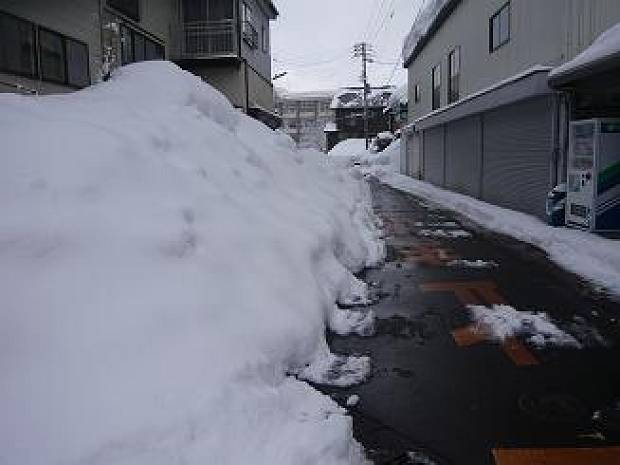
With enough hands, we can put away as much snow as this!
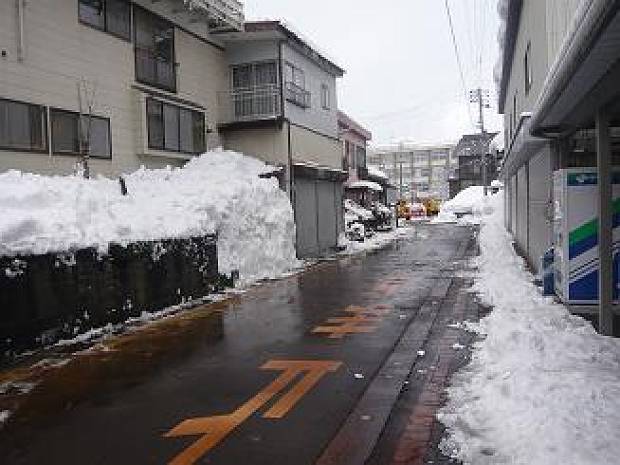
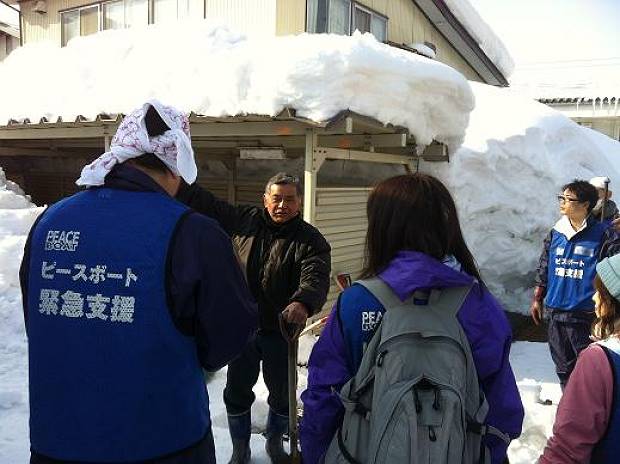
Local residents teaching volunteers how to use a shovel. Even inexperienced volunteers gradually got better at using it.
Although we do not know the exact amount of snow shovelled by volunteers as new snow fell each day, the area covered was approximately 29,471 m3 in 30 activity sites, calculated as the amount of snowfall on map (length×width×height=m3)
The weight of snow is stated below.
・New-fallen snow: approximately 50 kg ~150kg
・Lightly compacted snow: approximately 150 kg~250kg
・Compacted snow: approximately 250kg~500kg
・Granular snow: 300kg~500kg
Therefore volunteers removed at least 147.4t (50kg/m2, used for this calculation) in this activity.
Considering that many of the locations were lightly-compacted or compacted snow, the more precise number would be 589.4t (200kg/m2)
Many volunteers who had also experienced working in Ishinomaki or Wakayama also joined these activities. One of whom was Hikichi Fumie, below.
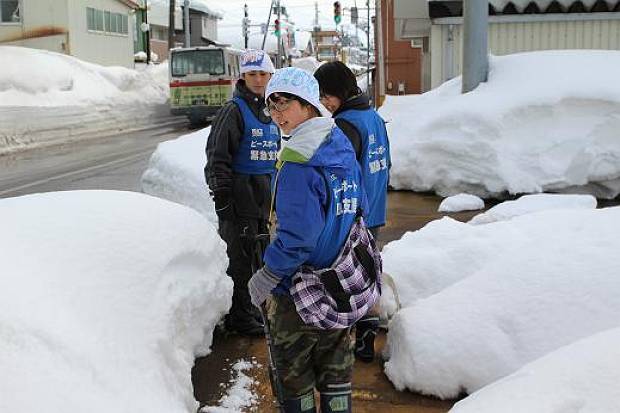
AT the front: Hikichi Fumie, who volunteered to clear snow twice – at both the beginning and end of the programme period.
Q:
What made you take part in the volunteering program in Ojiya City?
A:
I had known about Peace Boat long before volunteering. In fact, I wanted to participate in Peace Boat’s global voyage. I took part in the disaster relief volunteering for the first time last July and went to Ishinomaki. I have been there several times since, and I was there for most of last December to engage in temporary housing support. Also, I went to Wakayama as part of Peace Boat’s emergency support program for typhoon damage.
Q:
You also participated in the Volunteer Leader Training Programme?
A:
Yes, it made me realize that there is much more to think about than when I was just doing voluntary work. Because my first volunteering experience was last July, I don’t know much about the situation in the immediate aftermath of the disaster. I came to face the planning phase of volunteering program for the first time in Niigata, and I also got to practice on the spot what I had learned in the training such as creating frameworks to coordinate volunteers. It taught me to keep this in mind the importance of connection with people and how we are involved.
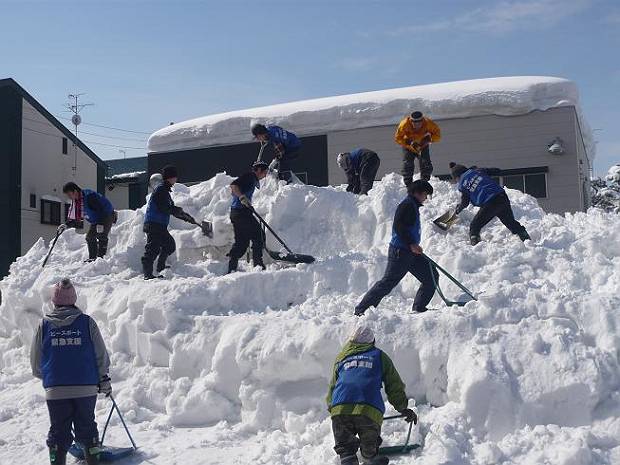
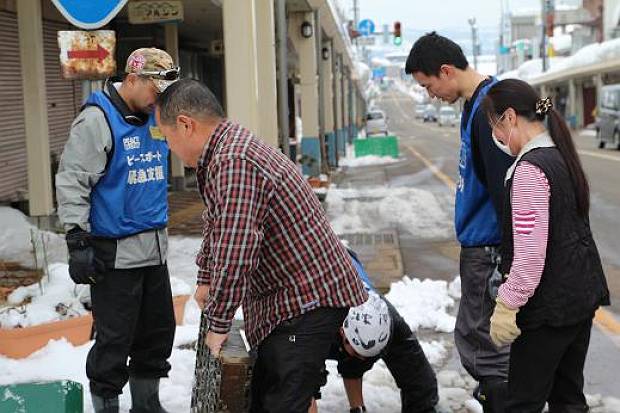
Q:
How did you felt about your activities in Ojiya?
A:
Snow is really heavy!! It was quite strenuous work.
Until I experienced the actual work myself, it was just something on television. Through this experience I got to understand the hardship of people living in snowy districts better. At the same time I was glad that I came to know the strength of the people there living with that snow. I talked with the residents about many things too. I will never forget the story Mr Iwabuchi (nickname: Kometa) who taught us the basics of snow clearing, shared with us.
Q:
Will you tell us a little bit about the story?
A:
Sure. On February 29 when we finished the activity, I was relaxing at the accommodation with some time before getting on the bus to go back to Tokyo. Mr Shinbo, who had shared food with us many times, visited, and we called Kometa to come and have some tea with us.
Kometa has lived in Ojiya all his life except his school days in Tokyo. His life changed dramatically when a student who, amid the confusion in the wake of the Chuetsu Earthquake in Niigata, was left behind at a primary school and later died. “At that time I wasn’t able to save someone I could have saved. This town has come to shoulder the regret and pain. Also all of us in this area have been damaged too. It’s not only me that is affected so I cannot say I feel distressed. But I do feel the pain.”
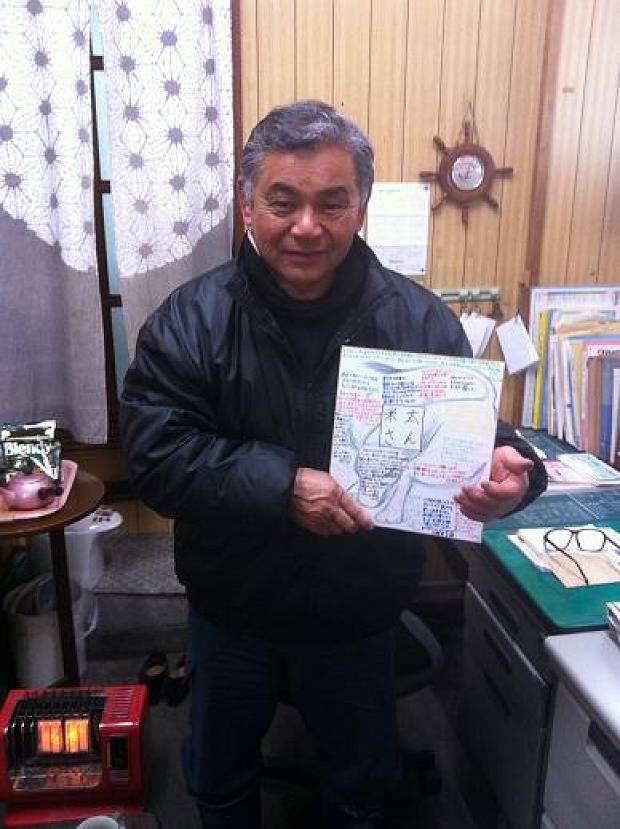
Q:
As well as the physical oncrete damages, the memory of the disaster must have remained ….
A:
That is likely true. But that’s not the only thing I cannot forget. It’s the words he muttered after that.
“Around that time, it was volunteers who filled in the cracks in my heart, to tell the truth. They worked so hard even though it was not where they lived. Also we were able to tell the young volunteers about complaints or something I was at a loss, because I hadn’t known them before.”
That made me realize that was why people in the town had welcomed us so warmly this time as well. Also that the relationship between people, which the volunteers who had came before built, still remains strong.
I have heard it several times too; “The accumulation of every volunteer’s efforts so far has led to the current activity. That’s why all of our efforts now will be carried over.” The meaning of this phrase really hit me thanks to Kometa’s story. I hope to convey this to others too.
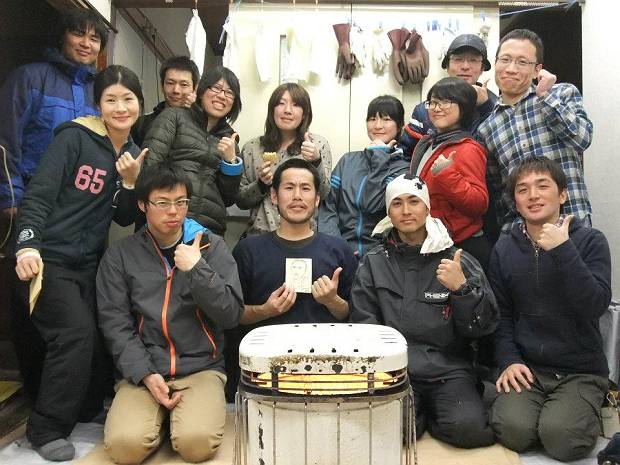
Q:
Although the concrete results of the volunteers’ work is indeed important, such as how many tons of snow was shovelled, this role of volunteers is also key.
A:
Just a little bit more I want to add.
The words from Kometa, “it was volunteers who filled in the cracks in my heart,” are like an answer to me in regards to what I hope to continue doing in Ishinomaki from now on. With activities such as serving emergency meals or removing mud, it is easy to see our achievements. But for activities like temporary housing support, sometimes I worried about whether I was really doing something useful for the people.
But I think we are now at the stage where these efforts are piling up. Be sincere and polite to people in front of you. As I don’t have any special skills, qualifications or talents, that is all I can do. I just hope that my own efforts will be continue to pile up, so that people will one day feel that “I am glad I got the chance to talk with volunteers that time.” That will definitely make me very happy. So I have to be sure to go to Ojiya again!
———–
Finally, this report features an interview with Kakinuki Norihiko, the staff member who launched the snow shovelling support activities, recruited and coordinated volunteers, and oversaw the latter phase of the on-site work.
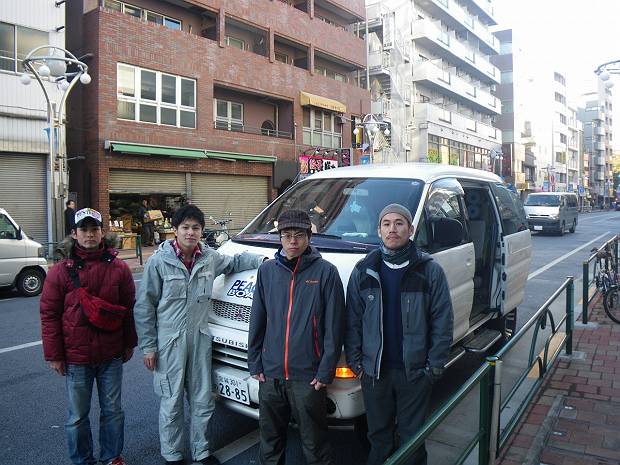
Far right: Kakinuki Norihiko, coordinator of snow-clearing volunteers.
Q:
How was this latest activity launched?
A:
On February 9, I went to Ojiya as a member of the advance team. After finding out what was needed, and meeting the local people involved, I came straight back to Tokyo. To get the greatest number of volunteers started as quickly as possible, I needed to put together the recruitment conditions and requirements, and to describe the situation there in a way that could be communicated to others. After consulting with other staff at the Tokyo office, late in the evening of February 12 I was able to put up a recruitment announcement on our web site. The following morning I was surprised and happy to see that we already had five applicants.
Meanwhile, in parallel, we approached volunteers whom we already knew personally. We had an especially quick response from those who had attended our Volunteer Leader Training Programme. On the following day we also had messages from a number of people who normally volunteer in our office, saying “I’ve managed to rearrange my work so I can join!” Once again I felt how, when times are tough, having friends who’ll immediately say “Let’s do it!” is a real source of strength.
Q:
Just under three weeks later, each day you had a total of 150 volunteers working with you. Once the flow of volunteers started you went back to Ojiya, correct?
A:
Right. Once volunteer recruitment was in hand, I passed the application processing on to other staff in the Tokyo office. Then on February 21 I went back to Ojiya. I swapped places with my colleague Narita, who had been site coordinator for the first phase, and then I stayed there until we pulled out on February 29.
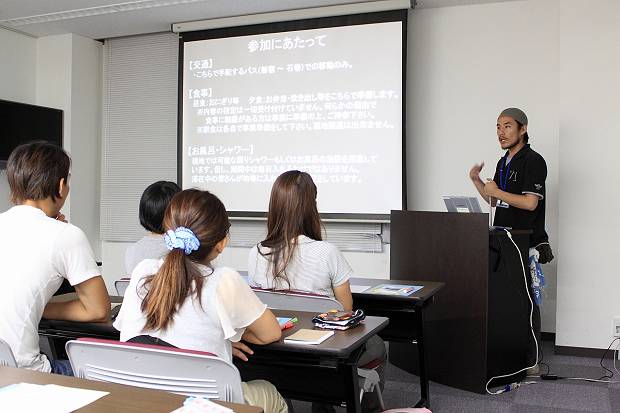
As Tokyo coordinator for volunteer dispatch to Ishinomaki
Q:
What impressions have you been left with, now the project is finished?
A:
To be honest, so many that it’s hard to believe it was only three weeks.
I guess one thing would be the way we put to use our earlier experiences and resources, at both the individual and the group levels. Having decided to go ahead with the project, we arranged one car loaded up with snow-clearing equipment from Ishinomaki. Adding to that a load of office items from Tokyo, we were all set with not just the obvious things like jackets, rubber boots and shovels, but also practical items such as a portable cooking stove, pots, and kettles, and even the blue vests identifying ourselves as volunteers. Being able to throw everything together so quickly was a big help.
My own experiences from last September, helping out in Wakayama after the typhoon flooding, were also really useful. For example, thinking to check transport timetables when setting up the first on-site meeting, so we could have an orientation session as soon as everyone arrived. Or knowing what kind of information is needed in the call for volunteers, and in the steps from receiving applications to bringing everyone together. Having to think everything through from scratch would have meant a lot more chaos.
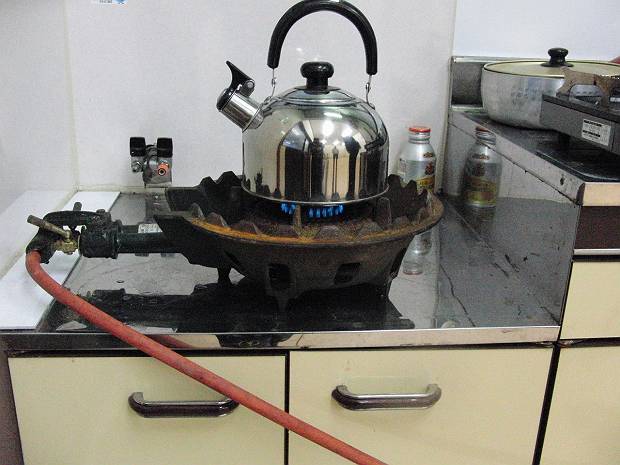
Vital equipment: the kettle we were lent.
Q:
Communication between the volunteer dispatch and receiving ends is harder than one might think. It’s hard for the dispatchers who haven’t seen the situation in person to form a clear image through words alone.
A:
I think that this time the fact that I had been part of the advance team helped our communications with the on-site staff, rapidly drilling down to the key points.
The advance team also included a member of the office volunteer staff, who went back to the office and started on-the-street fund raising in Tokyo. Sadly we still do not have financial reserves for dealing with new crises, beyond the basic management costs covered by our supporters. We make every effort to keep the on-site costs down, but of course money is still needed. His efforts in rallying the office volunteers to go out with him and collect donations became our funding lifeline.
In addition, even though they are volunteer staff, a lot of the people in the office have now been helping us for a long time, and have experience such as doing relief work in Ishinomaki and Wakayama. To some extent we can now hand over to them the responsibility for making arrangements, and they also help by looking after the newly arrived volunteers. It’s a huge help.
That’s true on site too. To start with, the locals were half-jokingly asking “You’ve never had to clear snow, right? Are you sure you’re OK?”, but in the end they were saying “Wow, you Peace Boat people really get things done.”
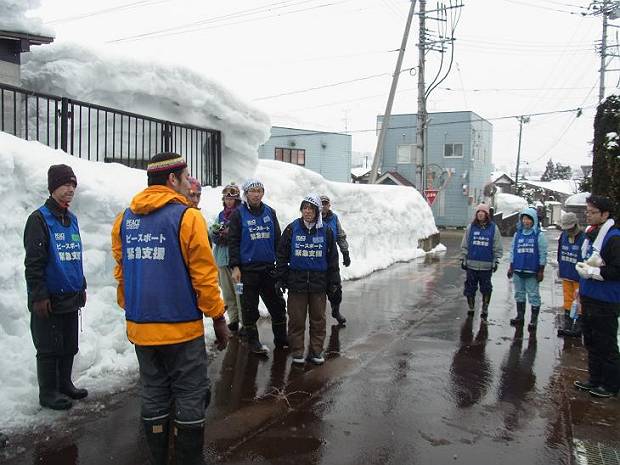
Q:
Tell us a bit more about the reaction of the local people.
A:
Our connection to Ojiya began with our relief efforts after the Chuetsu Earthquake in 2004. This time our liaison there was Mr Ige, from the town’s commercial district. He also helped with the snow-clearing work in 2006 and 2007. He really speeded things up for us – arranging accommodation and parking for the volunteers, introducing us to the local councillors and welfare organisations and to shop owners, and so on. Usually going into a new place involves several days of effort just to set up this kind of liaison.
What’s more, Mr Ige’s friends treated us like family, bringing us provisions every day, along with stoves, blankets, microwaves, pots etc.
Q:
Clearly having people like Mr Ige who actively work to make the most of the volunteers raises both the speed and the quality of your relief work.
A:
And in fact he gave us a further proposal, which was that they should have an Ojiya volunteer orientation. Apparently it was one of his friends who actually had the idea, which was to increase the recognition and awareness of the volunteering happening in Ojiya, and by doing so increase the region’s “relief receptiveness” during real times of need, especially in localities with a lot of older people. There’s still a lot of planning to be done, but we definitely want to go ahead with it. It’ll also give us another chance to visit Ojiya.
Q:
Anything you’d like to add in closing?
A:
The only thing I really want to do is thank all the people of Ojiya, and all the volunteers. And to say that we look forward to working with them from here on.



